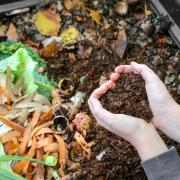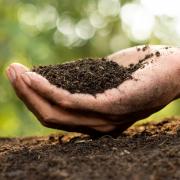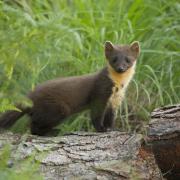Five citizen scientists tell Siân Ellis about their work monitoring the River Evenlode and its tributaries

Once a month Mary Ann and Russ Canning take a walk along the River Evenlode at Combe, pausing at the same two points each time, above and below the wastewater treatment works. Reaching out into the river with a pole they dip an empty bottle to collect samples of water upstream and down, then using a special kit they measure the samples for levels of phosphate and nitrate.
The pair also pour samples into a Secchi tube to gauge turbidity (cloudiness) of the water, measured by how easy it is to see a patterned disk at the bottom of the tube. They take pictures of the river and note details like the colour of the water, the speed of its flow, the presence of aquatic vegetation, algae and animal life, as well as surrounding land use.

Since 2019 Mary Ann and Russ have been citizen scientists and ‘catchment champions’ in a joint project between the Evenlode Catchment Partnership and Earthwatch. ‘We had been concerned about the cloudiness of our river, which you would swim in when young but wouldn’t want to now,’ Mary Ann says. ‘We wanted to do something practical to help towards finding out what the problem was and solving it. You get a real sense of satisfaction from doing it.’
The River Evenlode runs 72km from its source in Gloucestershire through Oxfordshire to the River Thames, and together with its tributaries forms a catchment of 430km2. There is much beautiful countryside but in recent decades watercourses – like many across the nation – have faced significant challenges ranging from pollution to physical modifications and climate change.
Voluntary citizen scientists like Mary Ann and Russ regularly monitor more than 20 river, stream and pond sites across the Evenlode catchment, gathering data to be used as evidence to press for water quality improvements. As Jenny Macdonald, another volunteer citizen scientist says: it’s important to take ownership of the situation. A lover of the outdoors (‘welly-boots are my preferred footwear’) Jenny monitors water quality on the Evenlode at Long Hanborough and Cassington Mill. ‘It’s rewarding to be a little piece of the jigsaw, making a difference to how the whole picture can be viewed.’


THE BIGGER PICTURE
Citizen scientist monitoring of water quality forms an important aspect of the work of the Evenlode Catchment Partnership (ECP). Led by Wild Oxfordshire (wildoxfordshire.org.uk), the ECP brings together members of the local community, Thames Water, the Environment Agency, the environmental charity Earthwatch, and others: to work towards improving the catchment for the benefit of wildlife and people. Thames Water has designated the Evenlode as one of three pilot Smarter Water Catchments and provided £3 million to fund initiatives to help look after the river environment.
None of the 18 waterbodies in the Evenlode catchment currently achieve ‘good’ ecological status – you can read all about why and the ECP’s plans to address this on Wild Oxfordshire’s website. The main causes of concern are phosphates and nitrates entering waterways from two key sources: in wastewater (and spills) from Sewage Treatment Works (STWs) and via agricultural run-off from fertilisers. While the nutrients naturally exist in freshwaters, additional amounts can lead to growth of excessive algae, blocking light, preventing plant growth, and reducing oxygen levels to the detriment of fish and other aquatic creatures.
But the ECP also reports good news – some streams and river sites show improvements in water quality. It continues to work with landowners/farmers, and to urge upgrades of sewage works, and notes that Thames Water will use collected water quality data as evidence to support investment to improve STWs in the catchment.

LONG-TERM DATA
Catchment champions attend Earthwatch-led training days at Combe Mill and are provided with kits to take phosphate and nitrate measurements above and below STWs, identifying differences in water quality, and also the effectiveness of any initiatives to reduce excessive nutrient levels. Monthly results are uploaded to the Earthwatch global citizen science project FreshWater Watch – the first Evenlode measurement was collected in 2017 (see earthwatch.org and freshwaterwatch.org).
The Environment Agency carries out monitoring too, but tight resources mean this has reduced considerably over the years. ‘So it’s really important that people take on this role,’ says catchment champion Frank Lucas. ‘Without citizen scientists this level of monitoring wouldn't get done, and it’s fantastic that we’re taking a catchment-wide approach here. Being involved in the project has made me much more aware of how rivers, streams and watercourses are interconnected.’
Frank, whose career background is in environmental and wildlife conservation, surveys two sites near the top of the catchment on the Four Shires Brook near Moreton-in-Marsh, one of which is downstream from both the STW and a thriving beef farm. ‘Water quality can vary quite quickly according to different factors; rain can bring silt off a field or it can dilute effluent, for example. One-off records are of interest but you really do need long-term data sets so that we can find out what the changes are, whether things are improving or getting worse.’ Seasonal patterns may also emerge.
Meanwhile Rufus, at 13 one of the younger citizen scientists involved with the ECP, has recently begun to monitor newly created ponds at Milton-under-Wychwood: sampling for nitrates, phosphates and turbidity to see how water quality improves as the ponds settle. ‘It is quite fun,’ he says, even though his very first outing was in challenging winter conditions.
Already involved with WASP (Windrush Against Sewage Pollution), Rufus has taken on volunteering work with the ECP as part of his Duke of Edinburgh’s Award programme. There is ‘lots of talk about the issues’ around the environment with his classmates at school, he says, and he ‘definitely’ has an interest in a future career in science.


FISH, BUGS AND TOES
In addition to testing for phosphates and nitrates, some ECP citizen scientists monitor invertebrates as an indicator of water quality, in conjunction with The Riverfly Partnership (riverflies.org). One such is John Pratt, a fisherman who noticed some 20 years ago that summer waters in the Evenlode, instead of being crystal clear, were turning the ‘colour of oxtail soup’. – ‘It was frustrating: the fish probably couldn’t see what I was offering them!’
Working at several sites on the Evenlode and its tributaries around Milton-under-Wychwood and Shipton-under-Wychwood, John does kick-samples: scuffling upstream stones and gathering the invertebrates that emerge into a sweep net. With his ‘bugs’ safely in a bucket, he uses a Riverfly-supplied photographic chart to double-check the identity of invertebrates, from caddisflies to freshwater shrimps. ‘I find shrimp populations upstream of the sewage works at Milton are far richer than those I come across downstream.’
‘There is still a good fish population in the Evenlode,’ he adds. ‘It is a very mixed fishery, including chub, trout, perch, roach, bream and minnows.’
The work of the ECP’s citizen scientists continues with enthusiasm and commitment, gathering data and promoting dialogue with all partners, determined that one day again, as John says, the waterways will be so clear that ‘when you go paddling up to your knees, you can still see your toes.’



























